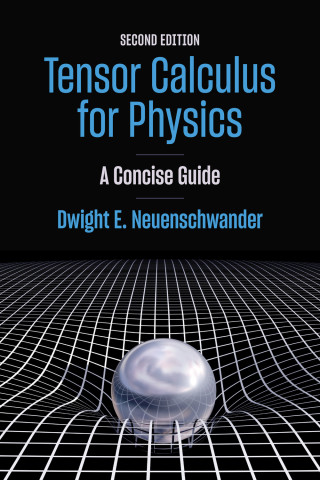
Book Details
Contents
Preface
Acknowledgements
1. Tensors Need Context
1.1. Why Aren't Tensors Defined by What They Are?
1.2. Euclidean Vectors, without Coordinates
1.3. Derivatives of Euclidean Vectors with Respect to
Contents
Preface
Acknowledgements
1. Tensors Need Context
1.1. Why Aren't Tensors Defined by What They Are?
1.2. Euclidean Vectors, without Coordinates
1.3. Derivatives of Euclidean Vectors with Respect to a Scalar
1.4. The Euclidean Gradient
1.5. Euclidean Vectors, with Coordinates
1.6. Euclidean Vector Operations with and without Coordinates
1.7. Transformation Coefficients as Partial Derivatives
1.8. What Is a Theory of Relativity?
1.9. Vectors Represented as Matrices
1.10. Discussion Questions and Exercises
2. Two-Index Tensors
2.1. The Electric Susceptibility Tensor
2.2. The Inertia Tensor
2.3. The Electric Quadrupole Tensor
2.4. The Electromagnetic Stress Tensor
2.5. Transformations of Two-Index Tensors
2.6. Finding Eigenvectors and Eigenvalues
2.7. Two-Index Tensor Components as Products of Vector Components
2.8. More Than Two Indices
2.9. Integration Measures and Tensor Densities
2.10. Discussion Questions and Exercises
3. The Metric Tensor
3.1. The Distinction between Distance and Coordinate Displacement
3.2. Relative Motion
3.3. Upper and Lower Indices
3.4. Converting between Vectors and Duals
3.5. Contravariant, Covariant, and "Ordinary" Vectors
3.6. Tensor Algebra
3.7. Tensor Densities Revisited
3.8. Discussion Questions and Exercises
4. Derivatives of Tensors
4.1. Signs of Trouble
4.2. The Affine Connection
4.3. The Newtonian Limit
4.4. Transformation of the Affine Connection
4.5. The Covariant Derivative
4.6. Relation of the Affine Connection to the Metric Tensor
4.7. Divergence, Curl, and Laplacian with Covariant Derivatives
4.8. Discussion Questions and Exercises
5. Curvature
5.1. What Is Curvature?
5.2. The Riemann Tensor
5.3. Measuring Curvature
5.4. Linearity in the Second Derivative
5.5. Discussion Questions and Exercises
6. Covariance Applications
6.1. Covariant Electrodynamics
6.2. General Covariance and Gravitation
6.3. Discussion Questions and Exercises
7. Tensors and Manifolds
7.1. Tangent Spaces, Charts, and Manifolds
7.2. Metrics on Manifolds and Their Tangent Spaces
7.3. Dual Basis Vectors
7.4. Derivatives of Basis Vectors and the Affine Connection
7.5. Discussion Questions and Exercises
8. Getting Acquainted with Differential Forms
8.1. Tensors as Multilinear Forms
8.2. 1-Forms (or Covariant Vectors Re-Imagined) and Their Extensions
8.3. Exterior Products and Differential Forms
8.4. The Exterior Derivative
8.5. An Application to Physics: Maxwell's Equations
8.6. Integrals of Differential Forms
8.7. Discussion Questions and Exercises
Appendix A: Common Coordinate Systems
Appendix B: The Theorem of Alternatives
Appendix C: Abstract Vector Spaces
Bibliography
Index






